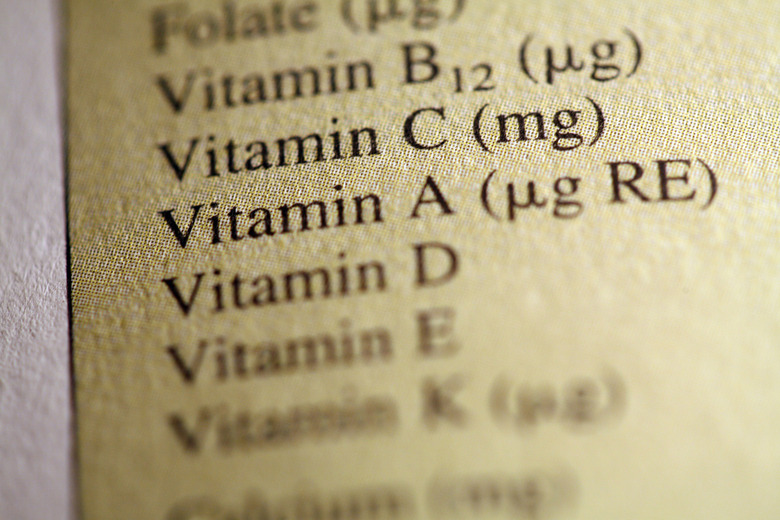What Role Do Vitamins Play In Enzyme Activity?
Vitamins are essential compounds that must be acquired through the diet because the body can't synthesize them. One of the reasons vitamins are needed is because they play an indirect role in catalysis, in which enzymes speed up chemical reactions. However, most vitamins can't help enzymes on their own. In order to participate in catalytic reactions, most vitamins have to change into coenzymes that are small "co-pilot" molecules that pair up with enzymes. These coenzymes are extremely useful because they stay the same after catalysis, so they're recycled and reused multiple times.
Converting Vitamins to Coenzymes
Converting Vitamins to Coenzymes
Most vitamins have to be converted into coenzymes before they can pair up with enzymes. These changes add small functional groups like phosphates to the vitamin structure, or they involve reduction-oxidation, or redox, reactions where electrons are either added or removed. For example, Vitamin B2 has to grab and bind to a phosphate group, PO3-, to form the coenzyme FMN. Folate is a vitamin that goes through a redox reaction and reduces two of its bonds by gaining electrons and it gets four hydrogens to form the coenzyme THF.
Coenzyme Reaction Mechanisms
Coenzyme Reaction Mechanisms
Coenzymes help enzymes by transferring electrons in redox reactions, or adding functional groups to substrates, which are converted into the final product by the enzyme. The functional groups that coenzymes add to the substrate are relatively small: the coenzyme PLP adds an amine group, -NH2, for example. Coenzymes also perform redox reactions. They either take electrons from the substrate or give electrons to it. These reactions are reversible and depend on the concentrations of both oxidized and reduced forms of the coenzyme. The more oxidized coenzymes are, the more reduction there will be, and vice versa.
Coenzymes And Metabolism
Coenzymes And Metabolism
Coenzymes carry out fairly simple chemical reactions, but these reactions have a major impact on metabolic functions. Vitamin K prevents blood clotting by speeding up the synthesis of gamma-carboxyglutamate, a molecule that binds to free-floating calcium ions. There is a lot less calcium buildup in the arteries, and a lower risk of heart disease. Energy is also stored in coenzymes during cellular respiration, during which cells obtain energy from breaking down food. This energy is released later on by oxidizing the stored coenzymes.
Recycling Coenzymes
Recycling Coenzymes
One of the primary characteristics of a coenzyme is that it isn't permanently changed by catalysis. Any changes in the coenzyme's structure are reversed before it's recycled. Coenzymes that participate in redox reactions, like FAD and NAD+, are converted back to their previous form by losing electrons. Not all coenzymes are changed back this quickly, especially coenzymes that transfer functional groups. For example, THF binds to a CH2 group and is converted to DHF after the reaction is finished. DHF is reduced to THF and the enzyme is reused.
References
- The Cell: A Molecular Approach – The Central Role Of Enzymes As Biological Catalysts
- Hamostaseologie: Role Of Vitamin K Dependent Proteins In The Arterial Vessel Wall
- Biochemistry: Vitamins Are Often Precursors To Coenzymes
- Rose-Hulman Institute Of Technology: Vitamins And Coenzymes
- UC Santa Barbara: Organic Mechanisms of Coenzymes
- Georgia State Hyperphysics: Coenzymes
- Georgia State Hyperphysics: TCA Cycle
- Georgia State Hyperphysics: Electron Transfer Reactions
Cite This Article
MLA
Auerbach, Scott. "What Role Do Vitamins Play In Enzyme Activity?" sciencing.com, https://www.sciencing.com/role-vitamins-play-enzyme-activity-9293/. 24 April 2017.
APA
Auerbach, Scott. (2017, April 24). What Role Do Vitamins Play In Enzyme Activity?. sciencing.com. Retrieved from https://www.sciencing.com/role-vitamins-play-enzyme-activity-9293/
Chicago
Auerbach, Scott. What Role Do Vitamins Play In Enzyme Activity? last modified August 30, 2022. https://www.sciencing.com/role-vitamins-play-enzyme-activity-9293/
